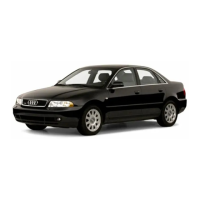
Do you have a question about the Audi A4 2001 and is the answer not in the manual?
| Brand | Audi |
|---|---|
| Model | A4 2001 |
| Category | Automobile |
| Language | English |
Details on the design and functional aspects of the new Audi A4.
General introduction to the service manual and self-study programme.
Highlights key technological advancements and features of the Audi A4.
Explains the fundamental design and engineering principles of the vehicle.
Covers aerodynamic improvements, safety standards, and communication systems.
Provides detailed exterior and interior dimensions of the Audi A4.
Explains the function and benefits of the vehicle's aero-floor.
Details structural elements for enhanced front impact protection.
Explains structural optimizations for side impact safety.
Describes the one-piece door shell and noise reduction measures.
Covers emergency door locking and luggage compartment features.
Presents a general view of the occupant protection system components.
Details the function and integration of front impact sensors.
Explains side impact sensors and the central airbag control unit.
Covers passenger airbag deactivation and front belt attachment.
Describes how crash signals trigger various vehicle functions.
Introduces the 4-cylinder and V6 petrol engines.
Details advancements in the 2.5L V6 TDI engine, including technical data.
Explains the design and improvements of the fuel injection pump.
Describes the new ICU injector and its impact on emissions.
Details the new charge air cooler design for optimal airflow.
Covers the new shift lever gate and "S" programme in the automatic gearbox.
Explains the "Tip in D" function for the multitronic gearbox.
Details the four-link front axle and its lightweight construction.
Describes the rear axle design for front-wheel and quattro versions.
Explains the three-point mounting system for engines and gearboxes.
Introduces ESP 5.7, its features, and the hydraulic modulator.
Illustrates the function and limitations of the single-stage ABS return pump.
Explains the design and operation of the two-stage ABS return pump.
Details the brake assistant's function in emergency braking situations.
Covers the brake fluid reservoir design and brake light switch adjustment.
Provides a visual overview of the vehicle's electrical system components.
Illustrates the CAN bus architecture connecting various control units.
Explains the extended CAN data bus and its communication protocols.
Details the functions and versions of the dash panel insert.
Describes the Auto-Check system and fuel gauge sender operation.
Covers diagnostics, plausibility checks, and mileage adaptation procedures.
Explains the components and functions of the steering column switch module.
Details ignition lock signals, steering angle sensing, and self-diagnosis.
Provides a diagram of the steering column switch module's functionality.
Explains the functions and connections of the central electrical system control unit.
Describes light control operations in different vehicle versions.
Presents the functional diagram for the lowline version of the control unit.
Presents the functional diagram for the highline version of the control unit.
Covers rear light operation, fault finding in lighting circuits.
Explains the control of turn signals and hazard warning lights.
Details the wash/wipe system, including re-wipe and reservoir design.
Describes the control unit for trailer recognition and its diagnostics.
Introduces the convenience system and its functions.
Details sensors and actuators processed by the central convenience electronics.
Explains the signals processed by door control units for various functions.
Covers mirror heating, fold-in, passenger mirror lowering, and diagnostics.
Details the anti-theft alarm with interior monitor and its activation/deactivation.
Highlights sounder innovation and diagnostics for the anti-theft system.
Explains the functional mechanism of the inclination sender for towing protection.
Introduces new generation radios, their features, and compatibility.
Details features of Chorus II, Concert II, and sound improvements in Concert II/Symphony II.
Covers Symphony II features, CAN networking, and signal inputs/outputs.
Provides examples of radio operation, diagnostics, and test modes.
Explains dynamic routing, traffic information sources, and route planning.
Details TMC data, its use in dynamic routing, and navigation diagnostics.
Describes the interface for Navigation Plus and its data exchange tasks.
Introduces the MCB for integrated aerials (GPS, GSM, radio, TV, remote control).
Covers TV tuner operation, switching, and self-diagnosis for aerials.
Details the automatic logbook system, its components, and PC requirements.
Explains operation modes (business, private), data storage, and activation.
Discusses the two-zone AC concept, innovations, and control unit.
Details the 7-piston compressor, its features, and identification.
Identifies key components and sensors within the air conditioner unit.
Explains the glove compartment cooling system and its performance.
Describes the optional solar roof, its advantages, and modifications.
Details the new fresh air blower's control unit, bearings, and solar input.
Lists various sensors and signals related to the HVAC system.
Provides a diagram of the fully automatic air conditioner system.
Explains the optional additional heater for coolant and its programming.
